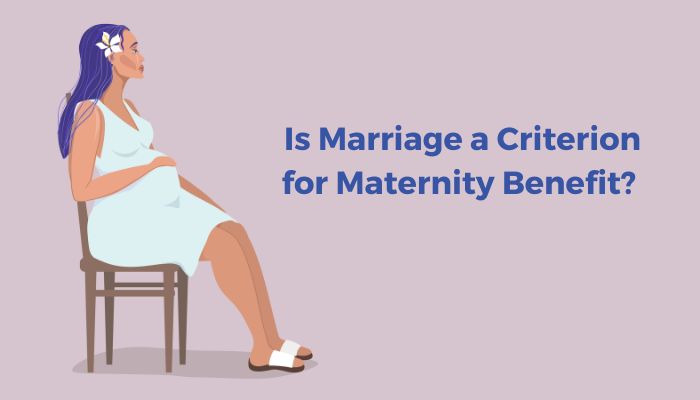The Maternity Benefit Act, 1961 is a social security legislation which is extended to every woman employee in an organization, enabling her to avail such benefits during pregnancy and while she conceives, as duly envisaged under the Act. A legal conundrum that may invoke some interpretative analysis governing the subject of Maternity Benefits under the Maternity Benefit Act, 1961 & Employee’s State Insurance Act, 1948 with specific reference to the status of a woman employee, i.e., married or unmarried, (including woman in a Live-in Relationships) spurs some provoking significance.
Referred below are the relevant provisions under the Maternity Benefit Act, 1961 to substantiate the said legal conundrum:
I. Maternity Benefit Act, 1961
- Section 3 – Definitions
In this Act, unless the context otherwise requires, —
(a) “Child” includes a still-born child;
(b) “Delivery” means the birth of a child;
(c) “Employer” means – (i) in relation to an establishment which is under the control of the Government, a person or authority appointed by the Government for the supervision and control of employees or where no person or authority is so appointed, the head of the department;
(d) “Woman” – means a woman employed, whether directly or through any agency, for wages in any establishment.
- Section 6 – Notice of claim for maternity benefit and payment thereof
(1) Any woman employed in an establishment and entitled to maternity benefit under the provisions of this Act may give notice in writing in such form as may be prescribed, to her employer, stating that her maternity benefit and any other amount to which she may be entitled under this Act may be paid to her or to such person as she may nominate in the notice and that she will not work in any establishment during the period for which she receives maternity benefit.
(2) In the case of a woman who is pregnant, such notice shall state the date from which she will be absent from work, not being a date earlier than eight weeks from the date of her expected delivery.
II. Employee’s State Insurance Act, 1948
- Section 46 – Benefits
(a) The insured persons, their dependants or the persons hereinafter mentioned, as the case may be, shall be entitled to the following benefit:
(b) periodical payments to an insured woman in case of confinement or miscarriage or sickness arising out of pregnancy, confinement, premature birth of child or miscarriage, such woman being certified to be eligible for such payments by an authority specified in this behalf by the regulations (hereinafter referred to as maternity benefit)
- Section 50 – Maternity Benefit
The qualification of an insured woman to claim maternity benefit, the conditions subject to which such benefit may be given, the rates and period thereof shall be such as may be prescribed by the Central Government.
III. Supreme Court Judgments on Live-in Relationships
In Badri Prasad v. Director of Consolidation (1978), the Supreme Court legitimised a 50-year long relationship of a couple. The bench stated that since the couple had lived together for a long time, there was strong presumption in favour of wedlock. And the law favoured the legitimacy of their relationship. Additionally, if any third party seeks to disprove such a presumption, a heavy burden lies on them.
In Payal Sharma v. Nari Niketan (2001), the Supreme Court affirmed that a man and woman could live together upon their willingness even without getting married. Demarcating the difference between law and morality, the Court expressed that even if live-in relationships are regarded as immoral by society, it is neither illegal nor an offence. Two individuals cohabiting and staying in a live-in relationship are not criminal offenders. It clarified that although socially unacceptable in parts of India, live-in relationships are neither a crime nor a sin.
Indra Sarma v. V.K.V. Sarma (2013), is a noteworthy case wherein the Supreme Court extensively deliberated on the subject of live-in relationships. The judgment delivered in this case serves as a basic framework or rulebook for matters on live-in relationships.
IV. Legal Status of Children Born Out of Live-in Relationship
In Balasubramanyam v. Suruttayan (1993), children born out of live-in relationships received the legal status of legitimacy for the first time. The Supreme Court said that if a man and woman live under the same roof and cohabit for considerable years, there will be a presumption of marriage under Section 114 of the Evidence Act. Therefore, the children born to them will be considered legitimate and rightfully entitled to receive a share in ancestral property.
V. TeamLease Comments
In India, under the Maternity Benefit Act, 1961 or Employees’ State Insurance Act, 1948 a woman employee is entitled for maternity benefit from her employer. However, the said Acts are totally silent about the marital status of the women.
Hence, an unmarried woman is also entitled to all maternity benefit like a married woman from his employer and there cannot be any discrimination between married and unmarried woman.
Source: TeamLease HRtech, Digitalising Employee Experience
You might also be interested to read: Monthly Compliance Roundup August 2022




